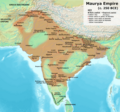파일:Maurya Empire, c.250 BCE.png

미리 보기 크기: 642 × 600 픽셀 다른 해상도: 257 × 240 픽셀 | 514 × 480 픽셀 | 822 × 768 픽셀 | 1,200 × 1,121 픽셀
원본 파일 (1,200 × 1,121 픽셀, 파일 크기: 2.3 MB, MIME 종류: image/png)
파일 역사
날짜/시간 링크를 클릭하면 해당 시간의 파일을 볼 수 있습니다.
| 날짜/시간 | 섬네일 | 크기 | 사용자 | 설명 | |
|---|---|---|---|---|---|
| 현재 | 2024년 1월 29일 (월) 11:15 |  | 1,200 × 1,121 (2.3 MB) | Avantiputra7 | as per discussions added labelling of provinces |
| 2023년 11월 22일 (수) 15:40 |  | 1,200 × 1,121 (2.06 MB) | Avantiputra7 | Reverted to version as of 05:59, 22 November 2023 (UTC) no justification for changing to less legible version of exactly the same map | |
| 2023년 11월 22일 (수) 15:14 |  | 1,500 × 1,309 (2.93 MB) | Indo12122 | Reverted to version as of 05:34, 22 November 2023 (UTC) Stop hijacking. | |
| 2023년 11월 22일 (수) 14:59 |  | 1,200 × 1,121 (2.06 MB) | Avantiputra7 | Reverted to version as of 05:06, 22 November 2023 (UTC) | |
| 2023년 11월 22일 (수) 14:34 |  | 1,500 × 1,309 (2.93 MB) | Indo12122 | Reverted to version as of 19:00, 21 November 2023 (UTC) | |
| 2023년 11월 22일 (수) 14:06 |  | 1,200 × 1,121 (2.06 MB) | Avantiputra7 | Reverted to version as of 18:13, 21 November 2023 (UTC) rv vandalism | |
| 2023년 11월 22일 (수) 04:00 |  | 1,500 × 1,309 (2.93 MB) | Indo12122 | Reverted to version as of 17:53, 21 November 2023 (UTC) Adding Gedrosia .Ray, Himanshu Prabha (2003). The Archaeology of Seafaring in Ancient South Asia. Cambridge University Press. ISBN 978-0-521-01109-9. In spite of the vagueness of the historical texts, the consensus among scholars is that the treaty concluded between Candragupta Maurya and Seleucus acknowledged Indian control of territories to the west of the Indus. These included Gedrosia, Paropamisadae (the region of Kabul and Begram) a... | |
| 2023년 11월 22일 (수) 03:13 |  | 1,200 × 1,121 (2.06 MB) | Avantiputra7 | Reverted to version as of 17:07, 21 November 2023 (UTC) no justification for changing to less legible version of exactly the same map | |
| 2023년 11월 22일 (수) 02:53 |  | 1,500 × 1,309 (2.93 MB) | Indo12122 | Reverted to version as of 16:58, 21 November 2023 (UTC) | |
| 2023년 11월 22일 (수) 02:07 |  | 1,200 × 1,121 (2.06 MB) | Avantiputra7 | Reverted to version as of 16:36, 21 November 2023 (UTC) |
이 파일을 사용하는 문서
다음 문서 1개가 이 파일을 사용하고 있습니다:
이 파일을 사용하고 있는 모든 위키의 문서 목록
다음 위키에서 이 파일을 사용하고 있습니다:
- en.wikipedia.org에서 이 파일을 사용하고 있는 문서 목록
- en.wiktionary.org에서 이 파일을 사용하고 있는 문서 목록
- hy.wikipedia.org에서 이 파일을 사용하고 있는 문서 목록
- sv.wikipedia.org에서 이 파일을 사용하고 있는 문서 목록
- ta.wikipedia.org에서 이 파일을 사용하고 있는 문서 목록
- zh.wikipedia.org에서 이 파일을 사용하고 있는 문서 목록
